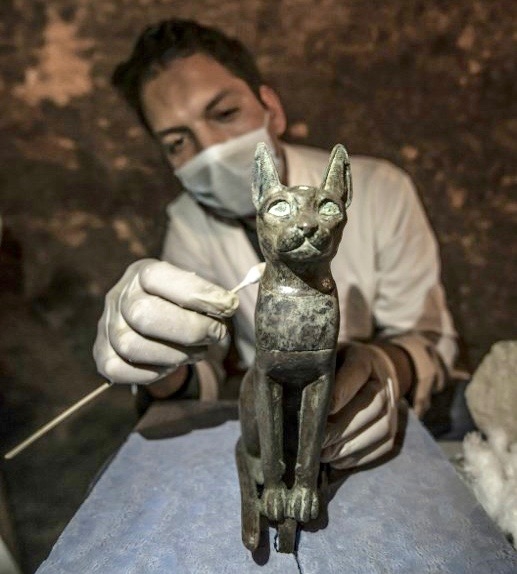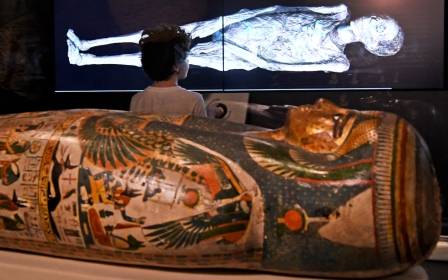Egypt cat statues, mummies discovered at site dating back 6,000 years

Statues of cats and seven sarcophagi, some dating back more than 6,000 years, have been discovered at a site on the edge of the pyramid complex in Saqqara, south of the Egyptian capital Cairo, archaeology officials said on Saturday.
A bronze statue dedicated to the cat goddess Bastet, along with 100 wooden, gilded statues of cats and dozens of cat mummies were also unearthed, AFP said.
Cats held a special place in Ancient Egypt and were mummified as religious offerings.
Antiquities Minister Khaled al-Enany said the discovery was made by an Egyptian archaeological mission during excavation work started in April.
Three of the tombs had been used for cats, he said, while one of four other sarcophagi discovered at the site belonged to Khufu-Imhat, overseer of the buildings in the royal palace.
Egypt's ancient relics are a draw for tourists and authorities hope new finds can also help attract more visitors.
Tourism in Egypt suffered in the aftermath of the mass protests that toppled former president Hosni Mubarak in 2011. Militant bomb attacks have also deterred foreign visitors. About 14.7 million people visited Egypt in 2010 before the uprising.
Egypt’s tourism revenue increased 77 percent in the first half of 2018 to about $4.8bn compared with the same period last year, a government official told Reuters. The number of tourists who visited Egypt in that time rose 41 percent to about 5 million.
As they were preparing the site to present the latest discoveries, archaeologists found the door of another tomb that remains sealed, Mostafa Waziri, secretary-general of Egypt's Supreme Council of Antiquities, told reporters.
The tomb dates from the Fifth Dynasty of the Old Kingdom and is unusual because the facade and door are intact, meaning its contents may still be untouched, said Mohamed Youssef, director of the Saqqara area. He said experts plan to open the tomb in the coming weeks, according to Reuters.
The Fifth Dynasty ruled Egypt from about 2,500 BC to 2,350 BC, not long after the great pyramid of Giza was built.
The tombs lie in a buried ridge that has only partially been uncovered and could offer many more similar discoveries, Waziri said. Excavations in the area had halted in 2013 before resuming earlier this year.
Saqqara served as the necropolis for Memphis, the capital of ancient Egypt for more than two millennia.
Ancient Egyptians mummified humans to preserve their bodies for the afterlife, while animal mummies were used as religious offerings.
Waziri said the mission had also unearthed the first mummies of scarabs to be found in the area.
Two large scarabs wrapped in linen and in very good condition were found inside a limestone sarcophagus with a vaulted, decorated lid, the antiquities ministry said in a statement.
Another collection of scarab mummies was found inside a smaller sarcophagus.
"The scarab is something really unique. It is something really a bit rare," Waziri said.
"A couple of days ago, when we discovered those coffins, they were sealed coffins with drawings of scarabs. I never heard about them before."
A collection of wooden gilded statues of a lion, a cow and a falcon was also unearthed at the Saqqara site.
New MEE newsletter: Jerusalem Dispatch
Sign up to get the latest insights and analysis on Israel-Palestine, alongside Turkey Unpacked and other MEE newsletters
Middle East Eye delivers independent and unrivalled coverage and analysis of the Middle East, North Africa and beyond. To learn more about republishing this content and the associated fees, please fill out this form. More about MEE can be found here.




